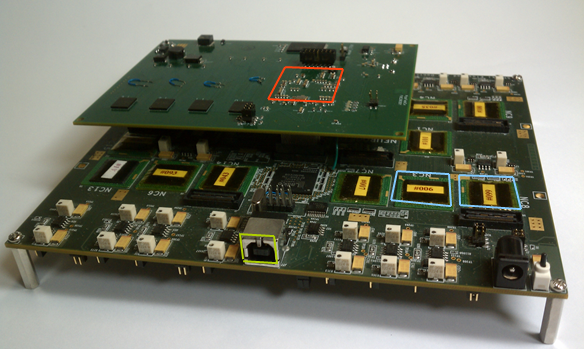Controlling Robot Dynamics With Spiking Neurons
NIPS 2013 Demonstration
Samir Menon, Sam Fok, Alex Neckar, Kevin Chavez, Chris Aholt, Scott Bertics, and Kwabena Boahen
Our lab recently developed Neurogrid, a neuromorphic chipset that emulates a million spiking neurons in real time. In this demo we will demonstrate Neurogrid controlling Neuroarm, a three degree-of-freedom force controlled robot arm.
There are three novel aspects to our demonstration:
- Real-time physical interaction between a human and a neuromorphic, compliant, force-controlled robotic system
- Non-linear dynamic control of the robot achieved by implementing operational space control on multiple spiking neuron populations.
- The application of the Neural Engineering Framework to real-world neuromorphic hardware and robotic systems, with physical noise and neural heterogeneity due to hardware mismatch.
spiking neuron network in Nengo implementing gravity compensation (B) and end-effector force control (C) for Neuroarm.
A fundamental problem while implementing robot control is to factorize the effect of the robot's non-linear dynamics from the trajectories that it must execute at the end-effector. Operational space control provides a general solution to this motor coordination problem and uses force control to combine the robot's forward dynamic model with trajectory control forces. The controller directly controls forces at the robot's generalized coordinates (joints).
For this demo, we controlled forces on Neuroarm by programming its force Jacobian, which maps hand forces into motor torques, on to a spiking neural network using the Neural Engineering Framework (NEF).

and have programmable connectivity through an FPGA (red). Neurogrid can communicate with a computer using USB (green).
A challenge to implementing computations onto spiking neural substrate is to operate with noisy, heterogeneous neurons on Neurogrid's neuromorphic hardware. NEF provides a principled method for mapping mathematical functions and dynamical systems onto a heterogeneous spiking neural substrate in a neurally plausible manner. NEF casts system inputs into the high dimensional space of neuron responses. First, each neuron is assigned an encoding vector, or preferred directions, and the system input is converted into input to each neuron by taking the inner product. After casting inputs into the high dimensional neural space, NEF finds the least-squares optimal decoding weights across each of the neural populations to approximate the desired function as the linear combination of neuron responses.
Acknowledgements
Credit to the Neurogrid team. Special thanks to Travis DeWolf for assisting in the demonstration setup.References
[2] Choudhary, S Sloan, S Fok, A Neckar, E Trautmann, P Gao, T Stewart, C Eliasmith, and K Boahen, "Silicon Neurons that Compute", International Conference on Artificial Neural Networks, LNCS vol 7552, pp 121-28, Springer, Heidelberg, 2012
[3] Sentis, L.; Jaeheung Park; Khatib, O., "Compliant Control of Multicontact and Center-of-Mass Behaviors in Humanoid Robots,", IEEE Transactions on Robotics, vol.26, no.3, pp.483,501, June 2010
[4] Eliasmith, Chris and Stewart, Terrence C. and Choo, Xuan and Bekolay, Trevor and DeWolf, Travis and Tang, Yichuan and Rasmussen, Daniel, “A Large-Scale Model of the Functioning Brain”,, Science, vol.338, no.6111, pp.1202,1205, November 2012